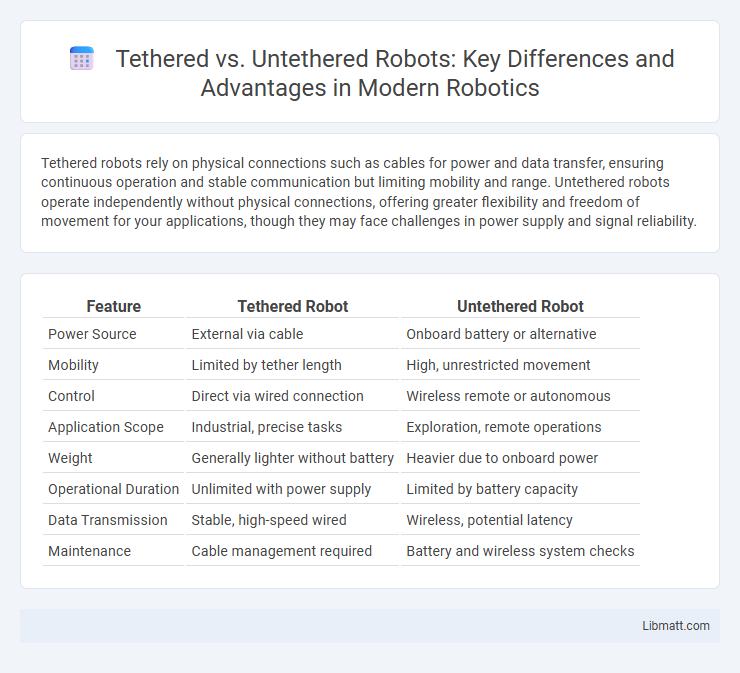Tethered robots rely on physical connections such as cables for power and data transfer, ensuring continuous operation and stable communication but limiting mobility and range. Untethered robots operate independently without physical connections, offering greater flexibility and freedom of movement for your applications, though they may face challenges in power supply and signal reliability.
Table of Comparison
| Feature | Tethered Robot | Untethered Robot |
|---|---|---|
| Power Source | External via cable | Onboard battery or alternative |
| Mobility | Limited by tether length | High, unrestricted movement |
| Control | Direct via wired connection | Wireless remote or autonomous |
| Application Scope | Industrial, precise tasks | Exploration, remote operations |
| Weight | Generally lighter without battery | Heavier due to onboard power |
| Operational Duration | Unlimited with power supply | Limited by battery capacity |
| Data Transmission | Stable, high-speed wired | Wireless, potential latency |
| Maintenance | Cable management required | Battery and wireless system checks |
Introduction to Tethered and Untethered Robots
Tethered robots rely on physical cables for power and data transmission, offering continuous energy supply and reliable communication but limited mobility. Untethered robots operate wirelessly, using onboard batteries and sensors to navigate freely in diverse environments, enhancing flexibility and range. Choosing your robot depends on the application's demand for either extended operation time or maneuverability.
Core Differences: Tethered vs Untethered Robots
Tethered robots rely on a physical connection, such as cables or wires, to receive power and transmit data, enabling continuous operation without battery limitations but restricting mobility and range. Untethered robots operate autonomously using onboard power sources, like batteries, allowing greater freedom of movement and flexibility in diverse environments at the cost of limited operational duration. The core difference lies in the trade-off between sustained energy supply and unrestricted mobility, affecting application suitability in fields like industrial automation, exploration, and medical robotics.
Power Supply: Limitations and Advantages
Tethered robots benefit from a continuous power supply through cables, enabling prolonged operation and higher energy demands without the need for heavy onboard batteries. Untethered robots rely on internal power sources such as batteries or fuel cells, offering greater mobility and flexibility but facing limitations in operational time and energy capacity. The choice between tethered and untethered power supply impacts robot design, mission duration, and application environments significantly.
Mobility and Operational Range
Tethered robots rely on physical cables for power and communication, limiting their operational range and mobility due to the cable's length and potential for entanglement. Untethered robots operate independently with onboard power sources, allowing greater freedom of movement and extended operational range in diverse environments. The choice between tethered and untethered systems impacts mission flexibility, especially in remote or hazardous locations.
Data Transmission and Control Methods
Tethered robots rely on physical cables for data transmission, enabling stable, high-bandwidth communication and precise control in real-time applications. Untethered robots use wireless technologies such as Wi-Fi, Bluetooth, or radio frequency, offering greater mobility but potentially introducing latency and limited data throughput. Your choice between these robots should balance the need for consistent data transfer with operational flexibility.
Use Cases for Tethered Robots
Tethered robots excel in underwater exploration, hazardous environment inspection, and industrial maintenance where continuous power supply and reliable data transmission are critical. Their ability to remain connected ensures real-time control and monitoring, making them ideal for deep-sea research, nuclear facility inspections, and pipeline assessments. Your operations benefit from enhanced safety and precision when using tethered robots in complex or high-risk scenarios.
Use Cases for Untethered Robots
Untethered robots excel in applications requiring high mobility and flexibility, such as search and rescue missions in hazardous environments where cables could entangle or restrict movement. They are also crucial in medical procedures, including minimally invasive surgeries, allowing precise navigation within the human body without the limitations of tethered connections. Furthermore, untethered robots facilitate remote exploration of difficult terrains, like underwater or extraterrestrial surfaces, by operating independently from power and communication lines.
Safety Considerations and Risk Factors
Tethered robots offer enhanced safety through constant power supply and communication link, reducing the risk of signal loss and unexpected shutdowns during operation in hazardous environments. Untethered robots, while providing greater mobility and flexibility, introduce higher risk factors such as limited battery life and potential control signal interruptions, which can compromise safe operation. Balancing your safety considerations involves assessing environment-specific risks and determining whether the consistent reliability of tethered systems or the autonomous freedom of untethered robots better suits your operational needs.
Cost Analysis: Tethered vs Untethered
Tethered robots generally incur lower initial costs due to simpler power supply and communication systems, relying on physical cables for continuous operation. Untethered robots, while offering greater mobility and flexibility, demand higher investment in onboard batteries, wireless communication modules, and advanced control systems, increasing upfront expenses. Long-term costs for tethered robots include cable maintenance and limited operational range, whereas untethered robots face battery replacement and potential downtime, impacting overall cost-effectiveness based on the application.
Choosing the Right Solution for Your Application
Tethered robots offer continuous power supply and reliable communication through physical connections, making them ideal for applications requiring long operational times and precise control. Untethered robots provide greater mobility and flexibility without the constraints of cables, suitable for environments where freedom of movement is critical. Understanding your application's power needs, operational environment, and control requirements ensures you select the most effective robot solution.
Tethered Robot vs Untethered Robot Infographic

 libmatt.com
libmatt.com